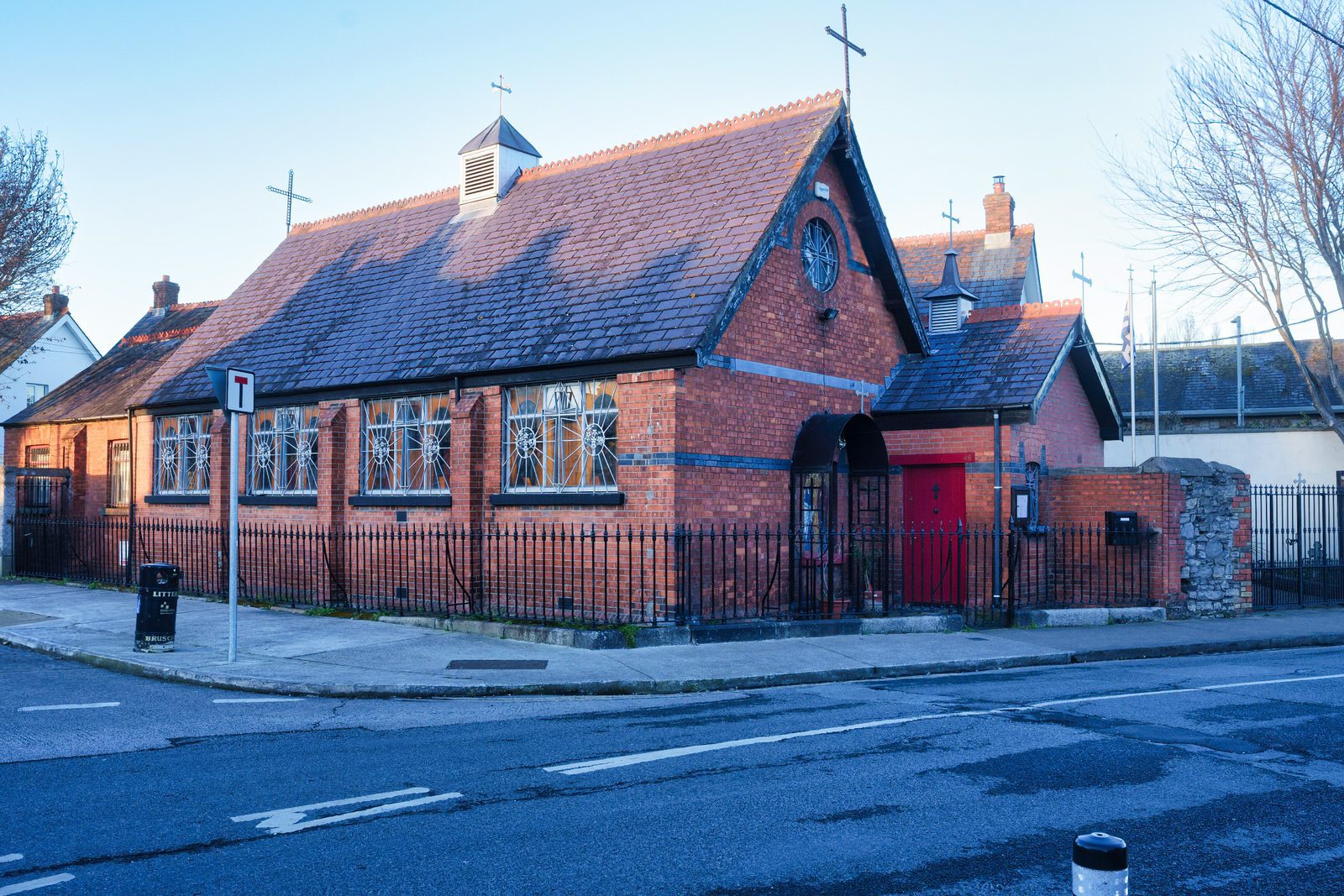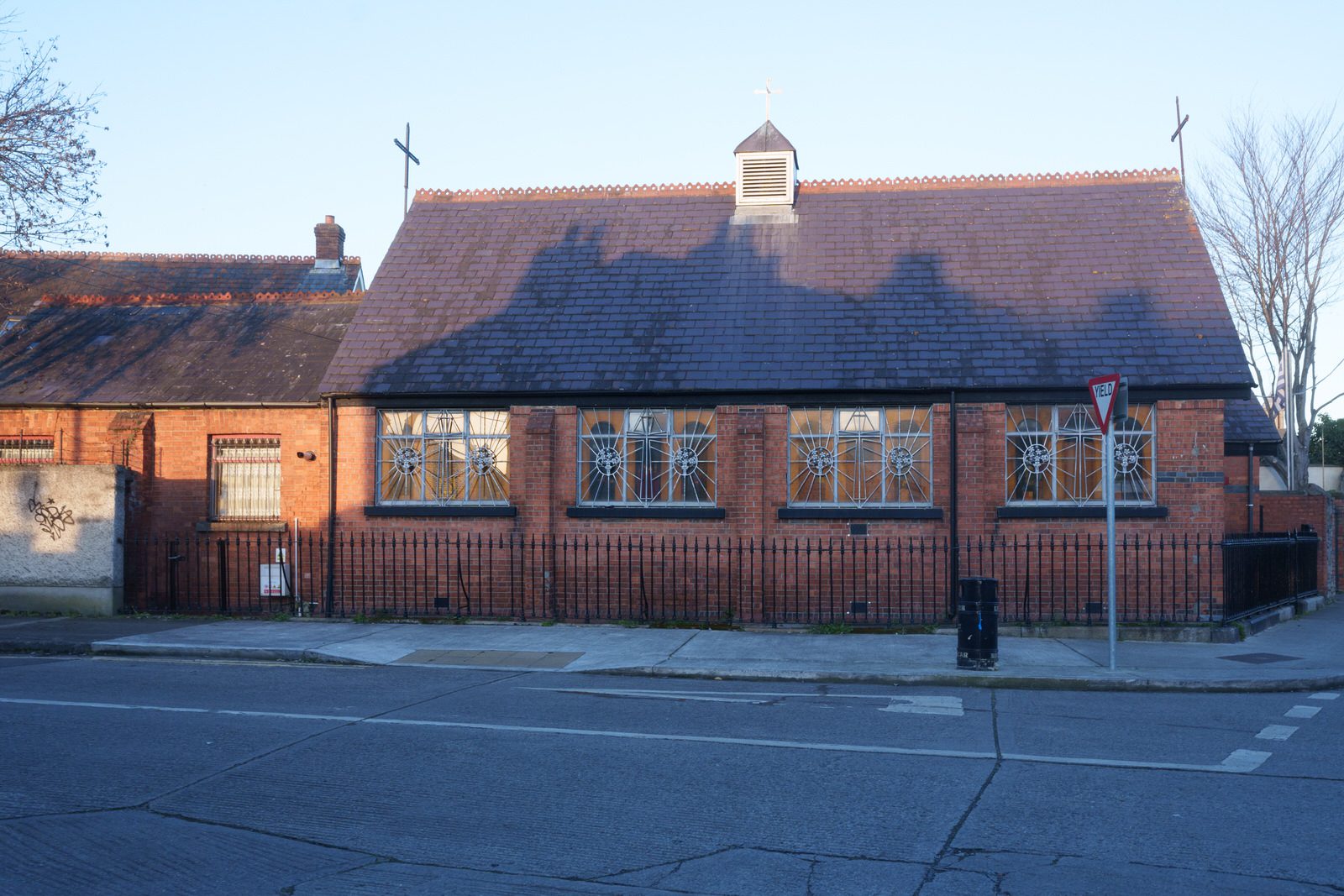21 MAY 2023
The Islamic Cultural Centre of Ireland is an Islamic complex, including a mosque, in Clonskeagh, Dublin, Ireland. It is funded by the al-Maktoum Foundation of Dubai and has a Sunni orientation.
The ICCI hosts the Muslim National School, a state funded primary school, with an Islamic ethos and with over 260 pupils. The religious department is sponsored by the al-Maktoum Foundation.
![CLONSKEAGH MOSQUE AND ISLAMIC CULTURAL CENTRE [ROEBUCK ROAD]-217056-1 CLONSKEAGH MOSQUE AND ISLAMIC CULTURAL CENTRE 010](https://excellentstreetimages.com/ChurchAndGraveWordPress/wp-content/uploads/2023/05/CLONSKEAGH-MOSQUE-AND-ISLAMIC-CULTURAL-CENTRE-ROEBUCK-ROAD-217056-1-1422x1067.jpg)
![CLONSKEAGH MOSQUE AND ISLAMIC CULTURAL CENTRE [ROEBUCK ROAD]-217053-1 CLONSKEAGH MOSQUE AND ISLAMIC CULTURAL CENTRE 009](https://excellentstreetimages.com/ChurchAndGraveWordPress/wp-content/uploads/2023/05/CLONSKEAGH-MOSQUE-AND-ISLAMIC-CULTURAL-CENTRE-ROEBUCK-ROAD-217053-1-1422x1067.jpg)
![CLONSKEAGH MOSQUE AND ISLAMIC CULTURAL CENTRE [ROEBUCK ROAD]-217054-1 CLONSKEAGH MOSQUE AND ISLAMIC CULTURAL CENTRE 008](https://excellentstreetimages.com/ChurchAndGraveWordPress/wp-content/uploads/2023/05/CLONSKEAGH-MOSQUE-AND-ISLAMIC-CULTURAL-CENTRE-ROEBUCK-ROAD-217054-1-1422x1067.jpg)
![CLONSKEAGH MOSQUE AND ISLAMIC CULTURAL CENTRE [ROEBUCK ROAD]-217055-1 CLONSKEAGH MOSQUE AND ISLAMIC CULTURAL CENTRE 007](https://excellentstreetimages.com/ChurchAndGraveWordPress/wp-content/uploads/2023/05/CLONSKEAGH-MOSQUE-AND-ISLAMIC-CULTURAL-CENTRE-ROEBUCK-ROAD-217055-1-1422x1067.jpg)
![CLONSKEAGH MOSQUE AND ISLAMIC CULTURAL CENTRE [ROEBUCK ROAD]-217051-1 CLONSKEAGH MOSQUE AND ISLAMIC CULTURAL CENTRE 006](https://excellentstreetimages.com/ChurchAndGraveWordPress/wp-content/uploads/2023/05/CLONSKEAGH-MOSQUE-AND-ISLAMIC-CULTURAL-CENTRE-ROEBUCK-ROAD-217051-1-1422x1067.jpg)
![CLONSKEAGH MOSQUE AND ISLAMIC CULTURAL CENTRE [ROEBUCK ROAD]-217052-1 CLONSKEAGH MOSQUE AND ISLAMIC CULTURAL CENTRE 005](https://excellentstreetimages.com/ChurchAndGraveWordPress/wp-content/uploads/2023/05/CLONSKEAGH-MOSQUE-AND-ISLAMIC-CULTURAL-CENTRE-ROEBUCK-ROAD-217052-1-1226x919.jpg)
![CLONSKEAGH MOSQUE AND ISLAMIC CULTURAL CENTRE [ROEBUCK ROAD]-217048-1 CLONSKEAGH MOSQUE AND ISLAMIC CULTURAL CENTRE 004](https://excellentstreetimages.com/ChurchAndGraveWordPress/wp-content/uploads/2023/05/CLONSKEAGH-MOSQUE-AND-ISLAMIC-CULTURAL-CENTRE-ROEBUCK-ROAD-217048-1-1422x1067.jpg)
![CLONSKEAGH MOSQUE AND ISLAMIC CULTURAL CENTRE [ROEBUCK ROAD]-217049-1 CLONSKEAGH MOSQUE AND ISLAMIC CULTURAL CENTRE 003](https://excellentstreetimages.com/ChurchAndGraveWordPress/wp-content/uploads/2023/05/CLONSKEAGH-MOSQUE-AND-ISLAMIC-CULTURAL-CENTRE-ROEBUCK-ROAD-217049-1-1553x1164.jpg)
![CLONSKEAGH MOSQUE AND ISLAMIC CULTURAL CENTRE [ROEBUCK ROAD]-217050-1 CLONSKEAGH MOSQUE AND ISLAMIC CULTURAL CENTRE 002](https://excellentstreetimages.com/ChurchAndGraveWordPress/wp-content/uploads/2023/05/CLONSKEAGH-MOSQUE-AND-ISLAMIC-CULTURAL-CENTRE-ROEBUCK-ROAD-217050-1-1286x965.jpg)
![CLONSKEAGH MOSQUE AND ISLAMIC CULTURAL CENTRE [ROEBUCK ROAD]-217047-1 CLONSKEAGH MOSQUE AND ISLAMIC CULTURAL CENTRE 001](https://excellentstreetimages.com/ChurchAndGraveWordPress/wp-content/uploads/2023/05/CLONSKEAGH-MOSQUE-AND-ISLAMIC-CULTURAL-CENTRE-ROEBUCK-ROAD-217047-1-1422x1067.jpg)
![WINDY ARBOUR GROTTO [PATRICK DOYLE ROAD]-217026-1 WINDY ARBOUR GROTTO 005](https://excellentstreetimages.com/ChurchAndGraveWordPress/wp-content/uploads/2023/05/WINDY-ARBOUR-GROTTO-PATRICK-DOYLE-ROAD-217026-1-1422x1067.jpg)
![WINDY ARBOUR GROTTO [PATRICK DOYLE ROAD]-217022-1 WINDY ARBOUR GROTTO 004](https://excellentstreetimages.com/ChurchAndGraveWordPress/wp-content/uploads/2023/05/WINDY-ARBOUR-GROTTO-PATRICK-DOYLE-ROAD-217022-1-1422x1067.jpg)
![WINDY ARBOUR GROTTO [PATRICK DOYLE ROAD]-217024-1 WINDY ARBOUR GROTTO 003](https://excellentstreetimages.com/ChurchAndGraveWordPress/wp-content/uploads/2023/05/WINDY-ARBOUR-GROTTO-PATRICK-DOYLE-ROAD-217024-1-1422x1067.jpg)
![WINDY ARBOUR GROTTO [PATRICK DOYLE ROAD]-217025-1 WINDY ARBOUR GROTTO 002](https://excellentstreetimages.com/ChurchAndGraveWordPress/wp-content/uploads/2023/05/WINDY-ARBOUR-GROTTO-PATRICK-DOYLE-ROAD-217025-1-1422x1067.jpg)
![WINDY ARBOUR GROTTO [PATRICK DOYLE ROAD]-217023-1 WINDY ARBOUR GROTTO 001](https://excellentstreetimages.com/ChurchAndGraveWordPress/wp-content/uploads/2023/05/WINDY-ARBOUR-GROTTO-PATRICK-DOYLE-ROAD-217023-1-1422x1067.jpg)
![GOLDENBRIDGE CEMETERY [GET OFF THE TRAM STOP AT DRIMNAGH RATHER THAN AT THE GOLDENBRIDGE STOP]-215844-1 GOLDENBRIDGE CEMETERY 088](https://excellentstreetimages.com/ChurchAndGraveWordPress/wp-content/uploads/2023/03/GOLDENBRIDGE-CEMETERY-GET-OFF-THE-TRAM-STOP-AT-DRIMNAGH-RATHER-THAN-AT-THE-GOLDENBRIDGE-STOP-215844-1.jpg)
![GOLDENBRIDGE CEMETERY [GET OFF THE TRAM STOP AT DRIMNAGH RATHER THAN AT THE GOLDENBRIDGE STOP]-215845-1 GOLDENBRIDGE CEMETERY 079](https://excellentstreetimages.com/ChurchAndGraveWordPress/wp-content/uploads/2023/03/GOLDENBRIDGE-CEMETERY-GET-OFF-THE-TRAM-STOP-AT-DRIMNAGH-RATHER-THAN-AT-THE-GOLDENBRIDGE-STOP-215845-1.jpg)
![GOLDENBRIDGE CEMETERY [GET OFF THE TRAM STOP AT DRIMNAGH RATHER THAN AT THE GOLDENBRIDGE STOP]-215846-1 GOLDENBRIDGE CEMETERY 078](https://excellentstreetimages.com/ChurchAndGraveWordPress/wp-content/uploads/2023/03/GOLDENBRIDGE-CEMETERY-GET-OFF-THE-TRAM-STOP-AT-DRIMNAGH-RATHER-THAN-AT-THE-GOLDENBRIDGE-STOP-215846-1.jpg)
![GOLDENBRIDGE CEMETERY [GET OFF THE TRAM STOP AT DRIMNAGH RATHER THAN AT THE GOLDENBRIDGE STOP]-215847-1 GOLDENBRIDGE CEMETERY 076](https://excellentstreetimages.com/ChurchAndGraveWordPress/wp-content/uploads/2023/03/GOLDENBRIDGE-CEMETERY-GET-OFF-THE-TRAM-STOP-AT-DRIMNAGH-RATHER-THAN-AT-THE-GOLDENBRIDGE-STOP-215847-1.jpg)
![GOLDENBRIDGE CEMETERY [GET OFF THE TRAM STOP AT DRIMNAGH RATHER THAN AT THE GOLDENBRIDGE STOP]-215848-1 GOLDENBRIDGE CEMETERY 075](https://excellentstreetimages.com/ChurchAndGraveWordPress/wp-content/uploads/2023/03/GOLDENBRIDGE-CEMETERY-GET-OFF-THE-TRAM-STOP-AT-DRIMNAGH-RATHER-THAN-AT-THE-GOLDENBRIDGE-STOP-215848-1.jpg)
![GOLDENBRIDGE CEMETERY [GET OFF THE TRAM STOP AT DRIMNAGH RATHER THAN AT THE GOLDENBRIDGE STOP]-215849-1 GOLDENBRIDGE CEMETERY 074](https://excellentstreetimages.com/ChurchAndGraveWordPress/wp-content/uploads/2023/03/GOLDENBRIDGE-CEMETERY-GET-OFF-THE-TRAM-STOP-AT-DRIMNAGH-RATHER-THAN-AT-THE-GOLDENBRIDGE-STOP-215849-1.jpg)
![GOLDENBRIDGE CEMETERY [GET OFF THE TRAM STOP AT DRIMNAGH RATHER THAN AT THE GOLDENBRIDGE STOP]-215833-1 GOLDENBRIDGE CEMETERY 073](https://excellentstreetimages.com/ChurchAndGraveWordPress/wp-content/uploads/2023/03/GOLDENBRIDGE-CEMETERY-GET-OFF-THE-TRAM-STOP-AT-DRIMNAGH-RATHER-THAN-AT-THE-GOLDENBRIDGE-STOP-215833-1.jpg)
![GOLDENBRIDGE CEMETERY [GET OFF THE TRAM STOP AT DRIMNAGH RATHER THAN AT THE GOLDENBRIDGE STOP]-215835-1 GOLDENBRIDGE CEMETERY 072](https://excellentstreetimages.com/ChurchAndGraveWordPress/wp-content/uploads/2023/03/GOLDENBRIDGE-CEMETERY-GET-OFF-THE-TRAM-STOP-AT-DRIMNAGH-RATHER-THAN-AT-THE-GOLDENBRIDGE-STOP-215835-1.jpg)
![GOLDENBRIDGE CEMETERY [GET OFF THE TRAM STOP AT DRIMNAGH RATHER THAN AT THE GOLDENBRIDGE STOP]-215837-1 GOLDENBRIDGE CEMETERY 071](https://excellentstreetimages.com/ChurchAndGraveWordPress/wp-content/uploads/2023/03/GOLDENBRIDGE-CEMETERY-GET-OFF-THE-TRAM-STOP-AT-DRIMNAGH-RATHER-THAN-AT-THE-GOLDENBRIDGE-STOP-215837-1.jpg)
![GOLDENBRIDGE CEMETERY [GET OFF THE TRAM STOP AT DRIMNAGH RATHER THAN AT THE GOLDENBRIDGE STOP]-215838-1 GOLDENBRIDGE CEMETERY 070](https://excellentstreetimages.com/ChurchAndGraveWordPress/wp-content/uploads/2023/03/GOLDENBRIDGE-CEMETERY-GET-OFF-THE-TRAM-STOP-AT-DRIMNAGH-RATHER-THAN-AT-THE-GOLDENBRIDGE-STOP-215838-1.jpg)
![GOLDENBRIDGE CEMETERY [GET OFF THE TRAM STOP AT DRIMNAGH RATHER THAN AT THE GOLDENBRIDGE STOP]-215839-1 GOLDENBRIDGE CEMETERY069](https://excellentstreetimages.com/ChurchAndGraveWordPress/wp-content/uploads/2023/03/GOLDENBRIDGE-CEMETERY-GET-OFF-THE-TRAM-STOP-AT-DRIMNAGH-RATHER-THAN-AT-THE-GOLDENBRIDGE-STOP-215839-1.jpg)
![GOLDENBRIDGE CEMETERY [GET OFF THE TRAM STOP AT DRIMNAGH RATHER THAN AT THE GOLDENBRIDGE STOP]-215840-1 GOLDENBRIDGE CEMETERY 068](https://excellentstreetimages.com/ChurchAndGraveWordPress/wp-content/uploads/2023/03/GOLDENBRIDGE-CEMETERY-GET-OFF-THE-TRAM-STOP-AT-DRIMNAGH-RATHER-THAN-AT-THE-GOLDENBRIDGE-STOP-215840-1.jpg)
![GOLDENBRIDGE CEMETERY [GET OFF THE TRAM STOP AT DRIMNAGH RATHER THAN AT THE GOLDENBRIDGE STOP]-215841-1 GOLDENBRIDGE CEMETERY 067](https://excellentstreetimages.com/ChurchAndGraveWordPress/wp-content/uploads/2023/03/GOLDENBRIDGE-CEMETERY-GET-OFF-THE-TRAM-STOP-AT-DRIMNAGH-RATHER-THAN-AT-THE-GOLDENBRIDGE-STOP-215841-1.jpg)
![GOLDENBRIDGE CEMETERY [GET OFF THE TRAM STOP AT DRIMNAGH RATHER THAN AT THE GOLDENBRIDGE STOP]-215842-1 GOLDENBRIDGE CEMETERY 066](https://excellentstreetimages.com/ChurchAndGraveWordPress/wp-content/uploads/2023/03/GOLDENBRIDGE-CEMETERY-GET-OFF-THE-TRAM-STOP-AT-DRIMNAGH-RATHER-THAN-AT-THE-GOLDENBRIDGE-STOP-215842-1.jpg)
![GOLDENBRIDGE CEMETERY [GET OFF THE TRAM STOP AT DRIMNAGH RATHER THAN AT THE GOLDENBRIDGE STOP]-215843-1 GOLDENBRIDGE CEMETERY 065](https://excellentstreetimages.com/ChurchAndGraveWordPress/wp-content/uploads/2023/03/GOLDENBRIDGE-CEMETERY-GET-OFF-THE-TRAM-STOP-AT-DRIMNAGH-RATHER-THAN-AT-THE-GOLDENBRIDGE-STOP-215843-1.jpg)
![GOLDENBRIDGE CEMETERY [GET OFF THE TRAM STOP AT DRIMNAGH RATHER THAN AT THE GOLDENBRIDGE STOP]-215830-1 GOLDENBRIDGE CEMETERY 064](https://excellentstreetimages.com/ChurchAndGraveWordPress/wp-content/uploads/2023/03/GOLDENBRIDGE-CEMETERY-GET-OFF-THE-TRAM-STOP-AT-DRIMNAGH-RATHER-THAN-AT-THE-GOLDENBRIDGE-STOP-215830-1.jpg)
![GOLDENBRIDGE CEMETERY [GET OFF THE TRAM STOP AT DRIMNAGH RATHER THAN AT THE GOLDENBRIDGE STOP]-215831-1 GOLDENBRIDGE CEMETERY 063](https://excellentstreetimages.com/ChurchAndGraveWordPress/wp-content/uploads/2023/03/GOLDENBRIDGE-CEMETERY-GET-OFF-THE-TRAM-STOP-AT-DRIMNAGH-RATHER-THAN-AT-THE-GOLDENBRIDGE-STOP-215831-1.jpg)
![GOLDENBRIDGE CEMETERY [GET OFF THE TRAM STOP AT DRIMNAGH RATHER THAN AT THE GOLDENBRIDGE STOP]-215832-1 GOLDENBRIDGE CEMETERY 062](https://excellentstreetimages.com/ChurchAndGraveWordPress/wp-content/uploads/2023/03/GOLDENBRIDGE-CEMETERY-GET-OFF-THE-TRAM-STOP-AT-DRIMNAGH-RATHER-THAN-AT-THE-GOLDENBRIDGE-STOP-215832-1.jpg)
![GOLDENBRIDGE CEMETERY [GET OFF THE TRAM STOP AT DRIMNAGH RATHER THAN AT THE GOLDENBRIDGE STOP]-215834-1 GOLDENBRIDGE CEMETERY 061](https://excellentstreetimages.com/ChurchAndGraveWordPress/wp-content/uploads/2023/03/GOLDENBRIDGE-CEMETERY-GET-OFF-THE-TRAM-STOP-AT-DRIMNAGH-RATHER-THAN-AT-THE-GOLDENBRIDGE-STOP-215834-1.jpg)
![GOLDENBRIDGE CEMETERY [GET OFF THE TRAM STOP AT DRIMNAGH RATHER THAN AT THE GOLDENBRIDGE STOP]-215836-1 GOLDENBRIDGE CEMETERY 060](https://excellentstreetimages.com/ChurchAndGraveWordPress/wp-content/uploads/2023/03/GOLDENBRIDGE-CEMETERY-GET-OFF-THE-TRAM-STOP-AT-DRIMNAGH-RATHER-THAN-AT-THE-GOLDENBRIDGE-STOP-215836-1.jpg)
![GOLDENBRIDGE CEMETERY [GET OFF THE TRAM STOP AT DRIMNAGH RATHER THAN AT THE GOLDENBRIDGE STOP]-215820-1 GOLDENBRIDGE CEMETERY 059](https://excellentstreetimages.com/ChurchAndGraveWordPress/wp-content/uploads/2023/03/GOLDENBRIDGE-CEMETERY-GET-OFF-THE-TRAM-STOP-AT-DRIMNAGH-RATHER-THAN-AT-THE-GOLDENBRIDGE-STOP-215820-1.jpg)
![GOLDENBRIDGE CEMETERY [GET OFF THE TRAM STOP AT DRIMNAGH RATHER THAN AT THE GOLDENBRIDGE STOP]-215824-1 GOLDENBRIDGE CEMETERY 058](https://excellentstreetimages.com/ChurchAndGraveWordPress/wp-content/uploads/2023/03/GOLDENBRIDGE-CEMETERY-GET-OFF-THE-TRAM-STOP-AT-DRIMNAGH-RATHER-THAN-AT-THE-GOLDENBRIDGE-STOP-215824-1.jpg)
![GOLDENBRIDGE CEMETERY [GET OFF THE TRAM STOP AT DRIMNAGH RATHER THAN AT THE GOLDENBRIDGE STOP]-215825-1 GOLDENBRIDGE CEMETERY 057](https://excellentstreetimages.com/ChurchAndGraveWordPress/wp-content/uploads/2023/03/GOLDENBRIDGE-CEMETERY-GET-OFF-THE-TRAM-STOP-AT-DRIMNAGH-RATHER-THAN-AT-THE-GOLDENBRIDGE-STOP-215825-1.jpg)
![GOLDENBRIDGE CEMETERY [GET OFF THE TRAM STOP AT DRIMNAGH RATHER THAN AT THE GOLDENBRIDGE STOP]-215826-1 GOLDENBRIDGE CEMETERY 056](https://excellentstreetimages.com/ChurchAndGraveWordPress/wp-content/uploads/2023/03/GOLDENBRIDGE-CEMETERY-GET-OFF-THE-TRAM-STOP-AT-DRIMNAGH-RATHER-THAN-AT-THE-GOLDENBRIDGE-STOP-215826-1.jpg)
![GOLDENBRIDGE CEMETERY [GET OFF THE TRAM STOP AT DRIMNAGH RATHER THAN AT THE GOLDENBRIDGE STOP]-215827-1 GOLDENBRIDGE CEMETERY 055](https://excellentstreetimages.com/ChurchAndGraveWordPress/wp-content/uploads/2023/03/GOLDENBRIDGE-CEMETERY-GET-OFF-THE-TRAM-STOP-AT-DRIMNAGH-RATHER-THAN-AT-THE-GOLDENBRIDGE-STOP-215827-1.jpg)
![GOLDENBRIDGE CEMETERY [GET OFF THE TRAM STOP AT DRIMNAGH RATHER THAN AT THE GOLDENBRIDGE STOP]-215828-1 GOLDENBRIDGE CEMETERY 054](https://excellentstreetimages.com/ChurchAndGraveWordPress/wp-content/uploads/2023/03/GOLDENBRIDGE-CEMETERY-GET-OFF-THE-TRAM-STOP-AT-DRIMNAGH-RATHER-THAN-AT-THE-GOLDENBRIDGE-STOP-215828-1.jpg)
![GOLDENBRIDGE CEMETERY [GET OFF THE TRAM STOP AT DRIMNAGH RATHER THAN AT THE GOLDENBRIDGE STOP]-215829-1 GOLDENBRIDGE CEMETERY 053](https://excellentstreetimages.com/ChurchAndGraveWordPress/wp-content/uploads/2023/03/GOLDENBRIDGE-CEMETERY-GET-OFF-THE-TRAM-STOP-AT-DRIMNAGH-RATHER-THAN-AT-THE-GOLDENBRIDGE-STOP-215829-1.jpg)
![GOLDENBRIDGE CEMETERY [GET OFF THE TRAM STOP AT DRIMNAGH RATHER THAN AT THE GOLDENBRIDGE STOP]-215818-1 GOLDENBRIDGE CEMETERY 052](https://excellentstreetimages.com/ChurchAndGraveWordPress/wp-content/uploads/2023/03/GOLDENBRIDGE-CEMETERY-GET-OFF-THE-TRAM-STOP-AT-DRIMNAGH-RATHER-THAN-AT-THE-GOLDENBRIDGE-STOP-215818-1.jpg)
![GOLDENBRIDGE CEMETERY [GET OFF THE TRAM STOP AT DRIMNAGH RATHER THAN AT THE GOLDENBRIDGE STOP]-215819-1 GOLDENBRIDGE CEMETERY 051](https://excellentstreetimages.com/ChurchAndGraveWordPress/wp-content/uploads/2023/03/GOLDENBRIDGE-CEMETERY-GET-OFF-THE-TRAM-STOP-AT-DRIMNAGH-RATHER-THAN-AT-THE-GOLDENBRIDGE-STOP-215819-1.jpg)
![GOLDENBRIDGE CEMETERY [GET OFF THE TRAM STOP AT DRIMNAGH RATHER THAN AT THE GOLDENBRIDGE STOP]-215821-1 GOLDENBRIDGE CEMETERY 050](https://excellentstreetimages.com/ChurchAndGraveWordPress/wp-content/uploads/2023/03/GOLDENBRIDGE-CEMETERY-GET-OFF-THE-TRAM-STOP-AT-DRIMNAGH-RATHER-THAN-AT-THE-GOLDENBRIDGE-STOP-215821-1.jpg)
![GOLDENBRIDGE CEMETERY [GET OFF THE TRAM STOP AT DRIMNAGH RATHER THAN AT THE GOLDENBRIDGE STOP]-215822-1 GOLDENBRIDGE CEMETERY 049](https://excellentstreetimages.com/ChurchAndGraveWordPress/wp-content/uploads/2023/03/GOLDENBRIDGE-CEMETERY-GET-OFF-THE-TRAM-STOP-AT-DRIMNAGH-RATHER-THAN-AT-THE-GOLDENBRIDGE-STOP-215822-1.jpg)
![GOLDENBRIDGE CEMETERY [GET OFF THE TRAM STOP AT DRIMNAGH RATHER THAN AT THE GOLDENBRIDGE STOP]-215823-1 GOLDENBRIDGE CEMETERY 048](https://excellentstreetimages.com/ChurchAndGraveWordPress/wp-content/uploads/2023/03/GOLDENBRIDGE-CEMETERY-GET-OFF-THE-TRAM-STOP-AT-DRIMNAGH-RATHER-THAN-AT-THE-GOLDENBRIDGE-STOP-215823-1.jpg)
![GOLDENBRIDGE CEMETERY [GET OFF THE TRAM STOP AT DRIMNAGH RATHER THAN AT THE GOLDENBRIDGE STOP]-215811-1 GOLDENBRIDGE CEMETERY 047](https://excellentstreetimages.com/ChurchAndGraveWordPress/wp-content/uploads/2023/03/GOLDENBRIDGE-CEMETERY-GET-OFF-THE-TRAM-STOP-AT-DRIMNAGH-RATHER-THAN-AT-THE-GOLDENBRIDGE-STOP-215811-1.jpg)
![GOLDENBRIDGE CEMETERY [GET OFF THE TRAM STOP AT DRIMNAGH RATHER THAN AT THE GOLDENBRIDGE STOP]-215812-1 GOLDENBRIDGE CEMETERY 046](https://excellentstreetimages.com/ChurchAndGraveWordPress/wp-content/uploads/2023/03/GOLDENBRIDGE-CEMETERY-GET-OFF-THE-TRAM-STOP-AT-DRIMNAGH-RATHER-THAN-AT-THE-GOLDENBRIDGE-STOP-215812-1.jpg)
![GOLDENBRIDGE CEMETERY [GET OFF THE TRAM STOP AT DRIMNAGH RATHER THAN AT THE GOLDENBRIDGE STOP]-215813-1 GOLDENBRIDGE CEMETERY 045](https://excellentstreetimages.com/ChurchAndGraveWordPress/wp-content/uploads/2023/03/GOLDENBRIDGE-CEMETERY-GET-OFF-THE-TRAM-STOP-AT-DRIMNAGH-RATHER-THAN-AT-THE-GOLDENBRIDGE-STOP-215813-1.jpg)
![GOLDENBRIDGE CEMETERY [GET OFF THE TRAM STOP AT DRIMNAGH RATHER THAN AT THE GOLDENBRIDGE STOP]-215814-1 GOLDENBRIDGE CEMETERY 044](https://excellentstreetimages.com/ChurchAndGraveWordPress/wp-content/uploads/2023/03/GOLDENBRIDGE-CEMETERY-GET-OFF-THE-TRAM-STOP-AT-DRIMNAGH-RATHER-THAN-AT-THE-GOLDENBRIDGE-STOP-215814-1.jpg)
![GOLDENBRIDGE CEMETERY [GET OFF THE TRAM STOP AT DRIMNAGH RATHER THAN AT THE GOLDENBRIDGE STOP]-215815-1 GOLDENBRIDGE CEMETERY 043](https://excellentstreetimages.com/ChurchAndGraveWordPress/wp-content/uploads/2023/03/GOLDENBRIDGE-CEMETERY-GET-OFF-THE-TRAM-STOP-AT-DRIMNAGH-RATHER-THAN-AT-THE-GOLDENBRIDGE-STOP-215815-1.jpg)
![GOLDENBRIDGE CEMETERY [GET OFF THE TRAM STOP AT DRIMNAGH RATHER THAN AT THE GOLDENBRIDGE STOP]-215816-1 GOLDENBRIDGE CEMETERY 042](https://excellentstreetimages.com/ChurchAndGraveWordPress/wp-content/uploads/2023/03/GOLDENBRIDGE-CEMETERY-GET-OFF-THE-TRAM-STOP-AT-DRIMNAGH-RATHER-THAN-AT-THE-GOLDENBRIDGE-STOP-215816-1.jpg)
![GOLDENBRIDGE CEMETERY [GET OFF THE TRAM STOP AT DRIMNAGH RATHER THAN AT THE GOLDENBRIDGE STOP]-215817-1 GOLDENBRIDGE CEMETERY 041](https://excellentstreetimages.com/ChurchAndGraveWordPress/wp-content/uploads/2023/03/GOLDENBRIDGE-CEMETERY-GET-OFF-THE-TRAM-STOP-AT-DRIMNAGH-RATHER-THAN-AT-THE-GOLDENBRIDGE-STOP-215817-1.jpg)
![GOLDENBRIDGE CEMETERY [GET OFF THE TRAM STOP AT DRIMNAGH RATHER THAN AT THE GOLDENBRIDGE STOP]-215805-1 GOLDENBRIDGE CEMETERY 040](https://excellentstreetimages.com/ChurchAndGraveWordPress/wp-content/uploads/2023/03/GOLDENBRIDGE-CEMETERY-GET-OFF-THE-TRAM-STOP-AT-DRIMNAGH-RATHER-THAN-AT-THE-GOLDENBRIDGE-STOP-215805-1.jpg)
![GOLDENBRIDGE CEMETERY [GET OFF THE TRAM STOP AT DRIMNAGH RATHER THAN AT THE GOLDENBRIDGE STOP]-215806-1 GOLDENBRIDGE CEMETERY 039](https://excellentstreetimages.com/ChurchAndGraveWordPress/wp-content/uploads/2023/03/GOLDENBRIDGE-CEMETERY-GET-OFF-THE-TRAM-STOP-AT-DRIMNAGH-RATHER-THAN-AT-THE-GOLDENBRIDGE-STOP-215806-1.jpg)
![GOLDENBRIDGE CEMETERY [GET OFF THE TRAM STOP AT DRIMNAGH RATHER THAN AT THE GOLDENBRIDGE STOP]-215807-1 GOLDENBRIDGE CEMETERY 038](https://excellentstreetimages.com/ChurchAndGraveWordPress/wp-content/uploads/2023/03/GOLDENBRIDGE-CEMETERY-GET-OFF-THE-TRAM-STOP-AT-DRIMNAGH-RATHER-THAN-AT-THE-GOLDENBRIDGE-STOP-215807-1.jpg)
![GOLDENBRIDGE CEMETERY [GET OFF THE TRAM STOP AT DRIMNAGH RATHER THAN AT THE GOLDENBRIDGE STOP]-215808-1 GOLDENBRIDGE CEMETERY 037](https://excellentstreetimages.com/ChurchAndGraveWordPress/wp-content/uploads/2023/03/GOLDENBRIDGE-CEMETERY-GET-OFF-THE-TRAM-STOP-AT-DRIMNAGH-RATHER-THAN-AT-THE-GOLDENBRIDGE-STOP-215808-1.jpg)
![GOLDENBRIDGE CEMETERY [GET OFF THE TRAM STOP AT DRIMNAGH RATHER THAN AT THE GOLDENBRIDGE STOP]-215809-1 GOLDENBRIDGE CEMETERY 036](https://excellentstreetimages.com/ChurchAndGraveWordPress/wp-content/uploads/2023/03/GOLDENBRIDGE-CEMETERY-GET-OFF-THE-TRAM-STOP-AT-DRIMNAGH-RATHER-THAN-AT-THE-GOLDENBRIDGE-STOP-215809-1.jpg)
![GOLDENBRIDGE CEMETERY [GET OFF THE TRAM STOP AT DRIMNAGH RATHER THAN AT THE GOLDENBRIDGE STOP]-215810-1 GOLDENBRIDGE CEMETERY 035](https://excellentstreetimages.com/ChurchAndGraveWordPress/wp-content/uploads/2023/03/GOLDENBRIDGE-CEMETERY-GET-OFF-THE-TRAM-STOP-AT-DRIMNAGH-RATHER-THAN-AT-THE-GOLDENBRIDGE-STOP-215810-1.jpg)
![GOLDENBRIDGE CEMETERY [GET OFF THE TRAM STOP AT DRIMNAGH RATHER THAN AT THE GOLDENBRIDGE STOP]-215802-1 GOLDENBRIDGE CEMETERY 034](https://excellentstreetimages.com/ChurchAndGraveWordPress/wp-content/uploads/2023/03/GOLDENBRIDGE-CEMETERY-GET-OFF-THE-TRAM-STOP-AT-DRIMNAGH-RATHER-THAN-AT-THE-GOLDENBRIDGE-STOP-215802-1.jpg)
![GOLDENBRIDGE CEMETERY [GET OFF THE TRAM STOP AT DRIMNAGH RATHER THAN AT THE GOLDENBRIDGE STOP]-215803-1 GOLDENBRIDGE CEMETERY 033](https://excellentstreetimages.com/ChurchAndGraveWordPress/wp-content/uploads/2023/03/GOLDENBRIDGE-CEMETERY-GET-OFF-THE-TRAM-STOP-AT-DRIMNAGH-RATHER-THAN-AT-THE-GOLDENBRIDGE-STOP-215803-1.jpg)
![GOLDENBRIDGE CEMETERY [GET OFF THE TRAM STOP AT DRIMNAGH RATHER THAN AT THE GOLDENBRIDGE STOP]-215804-1 GOLDENBRIDGE CEMETERY 032](https://excellentstreetimages.com/ChurchAndGraveWordPress/wp-content/uploads/2023/03/GOLDENBRIDGE-CEMETERY-GET-OFF-THE-TRAM-STOP-AT-DRIMNAGH-RATHER-THAN-AT-THE-GOLDENBRIDGE-STOP-215804-1.jpg)
![GOLDENBRIDGE CEMETERY [GET OFF THE TRAM STOP AT DRIMNAGH RATHER THAN AT THE GOLDENBRIDGE STOP]-215793-1 GOLDENBRIDGE CEMETERY 031](https://excellentstreetimages.com/ChurchAndGraveWordPress/wp-content/uploads/2023/03/GOLDENBRIDGE-CEMETERY-GET-OFF-THE-TRAM-STOP-AT-DRIMNAGH-RATHER-THAN-AT-THE-GOLDENBRIDGE-STOP-215793-1.jpg)
![GOLDENBRIDGE CEMETERY [GET OFF THE TRAM STOP AT DRIMNAGH RATHER THAN AT THE GOLDENBRIDGE STOP]-215794-1 GOLDENBRIDGE CEMETERY 030](https://excellentstreetimages.com/ChurchAndGraveWordPress/wp-content/uploads/2023/03/GOLDENBRIDGE-CEMETERY-GET-OFF-THE-TRAM-STOP-AT-DRIMNAGH-RATHER-THAN-AT-THE-GOLDENBRIDGE-STOP-215794-1.jpg)
![GOLDENBRIDGE CEMETERY [GET OFF THE TRAM STOP AT DRIMNAGH RATHER THAN AT THE GOLDENBRIDGE STOP]-215795-1 GOLDENBRIDGE CEMETERY 029](https://excellentstreetimages.com/ChurchAndGraveWordPress/wp-content/uploads/2023/03/GOLDENBRIDGE-CEMETERY-GET-OFF-THE-TRAM-STOP-AT-DRIMNAGH-RATHER-THAN-AT-THE-GOLDENBRIDGE-STOP-215795-1.jpg)
![GOLDENBRIDGE CEMETERY [GET OFF THE TRAM STOP AT DRIMNAGH RATHER THAN AT THE GOLDENBRIDGE STOP]-215796-1 GOLDENBRIDGE CEMETERY 028](https://excellentstreetimages.com/ChurchAndGraveWordPress/wp-content/uploads/2023/03/GOLDENBRIDGE-CEMETERY-GET-OFF-THE-TRAM-STOP-AT-DRIMNAGH-RATHER-THAN-AT-THE-GOLDENBRIDGE-STOP-215796-1.jpg)
![GOLDENBRIDGE CEMETERY [GET OFF THE TRAM STOP AT DRIMNAGH RATHER THAN AT THE GOLDENBRIDGE STOP]-215797-1 GOLDENBRIDGE CEMETERY 027](https://excellentstreetimages.com/ChurchAndGraveWordPress/wp-content/uploads/2023/03/GOLDENBRIDGE-CEMETERY-GET-OFF-THE-TRAM-STOP-AT-DRIMNAGH-RATHER-THAN-AT-THE-GOLDENBRIDGE-STOP-215797-1.jpg)
![GOLDENBRIDGE CEMETERY [GET OFF THE TRAM STOP AT DRIMNAGH RATHER THAN AT THE GOLDENBRIDGE STOP]-215798-1 GOLDENBRIDGE CEMETERY 026](https://excellentstreetimages.com/ChurchAndGraveWordPress/wp-content/uploads/2023/03/GOLDENBRIDGE-CEMETERY-GET-OFF-THE-TRAM-STOP-AT-DRIMNAGH-RATHER-THAN-AT-THE-GOLDENBRIDGE-STOP-215798-1.jpg)
![GOLDENBRIDGE CEMETERY [GET OFF THE TRAM STOP AT DRIMNAGH RATHER THAN AT THE GOLDENBRIDGE STOP]-215799-1 GOLDENBRIDGE CEMETERY 025](https://excellentstreetimages.com/ChurchAndGraveWordPress/wp-content/uploads/2023/03/GOLDENBRIDGE-CEMETERY-GET-OFF-THE-TRAM-STOP-AT-DRIMNAGH-RATHER-THAN-AT-THE-GOLDENBRIDGE-STOP-215799-1.jpg)
![GOLDENBRIDGE CEMETERY [GET OFF THE TRAM STOP AT DRIMNAGH RATHER THAN AT THE GOLDENBRIDGE STOP]-215800-1 GOLDENBRIDGE CEMETERY 024](https://excellentstreetimages.com/ChurchAndGraveWordPress/wp-content/uploads/2023/03/GOLDENBRIDGE-CEMETERY-GET-OFF-THE-TRAM-STOP-AT-DRIMNAGH-RATHER-THAN-AT-THE-GOLDENBRIDGE-STOP-215800-1.jpg)
![GOLDENBRIDGE CEMETERY [GET OFF THE TRAM STOP AT DRIMNAGH RATHER THAN AT THE GOLDENBRIDGE STOP]-215801-1 GOLDENBRIDGE CEMETERY 023](https://excellentstreetimages.com/ChurchAndGraveWordPress/wp-content/uploads/2023/03/GOLDENBRIDGE-CEMETERY-GET-OFF-THE-TRAM-STOP-AT-DRIMNAGH-RATHER-THAN-AT-THE-GOLDENBRIDGE-STOP-215801-1.jpg)
![GOLDENBRIDGE CEMETERY [GET OFF THE TRAM STOP AT DRIMNAGH RATHER THAN AT THE GOLDENBRIDGE STOP]-215787-1 GOLDENBRIDGE CEMETERY 022](https://excellentstreetimages.com/ChurchAndGraveWordPress/wp-content/uploads/2023/03/GOLDENBRIDGE-CEMETERY-GET-OFF-THE-TRAM-STOP-AT-DRIMNAGH-RATHER-THAN-AT-THE-GOLDENBRIDGE-STOP-215787-1.jpg)
![GOLDENBRIDGE CEMETERY [GET OFF THE TRAM STOP AT DRIMNAGH RATHER THAN AT THE GOLDENBRIDGE STOP]-215789-1 GOLDENBRIDGE CEMETERY 021](https://excellentstreetimages.com/ChurchAndGraveWordPress/wp-content/uploads/2023/03/GOLDENBRIDGE-CEMETERY-GET-OFF-THE-TRAM-STOP-AT-DRIMNAGH-RATHER-THAN-AT-THE-GOLDENBRIDGE-STOP-215789-1.jpg)
![GOLDENBRIDGE CEMETERY [GET OFF THE TRAM STOP AT DRIMNAGH RATHER THAN AT THE GOLDENBRIDGE STOP]-215791-1 GOLDENBRIDGE CEMETERY 020](https://excellentstreetimages.com/ChurchAndGraveWordPress/wp-content/uploads/2023/03/GOLDENBRIDGE-CEMETERY-GET-OFF-THE-TRAM-STOP-AT-DRIMNAGH-RATHER-THAN-AT-THE-GOLDENBRIDGE-STOP-215791-1.jpg)
![GOLDENBRIDGE CEMETERY [GET OFF THE TRAM STOP AT DRIMNAGH RATHER THAN AT THE GOLDENBRIDGE STOP]-215792-1 GOLDENBRIDGE CEMETERY 019](https://excellentstreetimages.com/ChurchAndGraveWordPress/wp-content/uploads/2023/03/GOLDENBRIDGE-CEMETERY-GET-OFF-THE-TRAM-STOP-AT-DRIMNAGH-RATHER-THAN-AT-THE-GOLDENBRIDGE-STOP-215792-1.jpg)
![GOLDENBRIDGE CEMETERY [GET OFF THE TRAM STOP AT DRIMNAGH RATHER THAN AT THE GOLDENBRIDGE STOP]-215784-1 GOLDENBRIDGE CEMETERY 018](https://excellentstreetimages.com/ChurchAndGraveWordPress/wp-content/uploads/2023/03/GOLDENBRIDGE-CEMETERY-GET-OFF-THE-TRAM-STOP-AT-DRIMNAGH-RATHER-THAN-AT-THE-GOLDENBRIDGE-STOP-215784-1.jpg)
![GOLDENBRIDGE CEMETERY [GET OFF THE TRAM STOP AT DRIMNAGH RATHER THAN AT THE GOLDENBRIDGE STOP]-215785-1 GOLDENBRIDGE CEMETERY 017](https://excellentstreetimages.com/ChurchAndGraveWordPress/wp-content/uploads/2023/03/GOLDENBRIDGE-CEMETERY-GET-OFF-THE-TRAM-STOP-AT-DRIMNAGH-RATHER-THAN-AT-THE-GOLDENBRIDGE-STOP-215785-1.jpg)
![GOLDENBRIDGE CEMETERY [GET OFF THE TRAM STOP AT DRIMNAGH RATHER THAN AT THE GOLDENBRIDGE STOP]-215786-1 GOLDENBRIDGE CEMETERY 016](https://excellentstreetimages.com/ChurchAndGraveWordPress/wp-content/uploads/2023/03/GOLDENBRIDGE-CEMETERY-GET-OFF-THE-TRAM-STOP-AT-DRIMNAGH-RATHER-THAN-AT-THE-GOLDENBRIDGE-STOP-215786-1.jpg)
![GOLDENBRIDGE CEMETERY [GET OFF THE TRAM STOP AT DRIMNAGH RATHER THAN AT THE GOLDENBRIDGE STOP]-215788-1 GOLDENBRIDGE CEMETERY 015](https://excellentstreetimages.com/ChurchAndGraveWordPress/wp-content/uploads/2023/03/GOLDENBRIDGE-CEMETERY-GET-OFF-THE-TRAM-STOP-AT-DRIMNAGH-RATHER-THAN-AT-THE-GOLDENBRIDGE-STOP-215788-1.jpg)
![GOLDENBRIDGE CEMETERY [GET OFF THE TRAM STOP AT DRIMNAGH RATHER THAN AT THE GOLDENBRIDGE STOP]-215790-1 GOLDENBRIDGE CEMETERY 014](https://excellentstreetimages.com/ChurchAndGraveWordPress/wp-content/uploads/2023/03/GOLDENBRIDGE-CEMETERY-GET-OFF-THE-TRAM-STOP-AT-DRIMNAGH-RATHER-THAN-AT-THE-GOLDENBRIDGE-STOP-215790-1.jpg)
![GOLDENBRIDGE CEMETERY [GET OFF THE TRAM STOP AT DRIMNAGH RATHER THAN AT THE GOLDENBRIDGE STOP]-215773-1 GOLDENBRIDGE CEMETERY 013](https://excellentstreetimages.com/ChurchAndGraveWordPress/wp-content/uploads/2023/03/GOLDENBRIDGE-CEMETERY-GET-OFF-THE-TRAM-STOP-AT-DRIMNAGH-RATHER-THAN-AT-THE-GOLDENBRIDGE-STOP-215773-1.jpg)
![GOLDENBRIDGE CEMETERY [GET OFF THE TRAM STOP AT DRIMNAGH RATHER THAN AT THE GOLDENBRIDGE STOP]-215775-1 GOLDENBRIDGE CEMETERY 012](https://excellentstreetimages.com/ChurchAndGraveWordPress/wp-content/uploads/2023/03/GOLDENBRIDGE-CEMETERY-GET-OFF-THE-TRAM-STOP-AT-DRIMNAGH-RATHER-THAN-AT-THE-GOLDENBRIDGE-STOP-215775-1.jpg)
![GOLDENBRIDGE CEMETERY [GET OFF THE TRAM STOP AT DRIMNAGH RATHER THAN AT THE GOLDENBRIDGE STOP]-215779-1 GOLDENBRIDGE CEMETERY 011](https://excellentstreetimages.com/ChurchAndGraveWordPress/wp-content/uploads/2023/03/GOLDENBRIDGE-CEMETERY-GET-OFF-THE-TRAM-STOP-AT-DRIMNAGH-RATHER-THAN-AT-THE-GOLDENBRIDGE-STOP-215779-1.jpg)
![GOLDENBRIDGE CEMETERY [GET OFF THE TRAM STOP AT DRIMNAGH RATHER THAN AT THE GOLDENBRIDGE STOP]-215780-1 GOLDENBRIDGE CEMETERY 010](https://excellentstreetimages.com/ChurchAndGraveWordPress/wp-content/uploads/2023/03/GOLDENBRIDGE-CEMETERY-GET-OFF-THE-TRAM-STOP-AT-DRIMNAGH-RATHER-THAN-AT-THE-GOLDENBRIDGE-STOP-215780-1.jpg)
![GOLDENBRIDGE CEMETERY [GET OFF THE TRAM STOP AT DRIMNAGH RATHER THAN AT THE GOLDENBRIDGE STOP]-215781-1 GOLDENBRIDGE CEMETERY 009](https://excellentstreetimages.com/ChurchAndGraveWordPress/wp-content/uploads/2023/03/GOLDENBRIDGE-CEMETERY-GET-OFF-THE-TRAM-STOP-AT-DRIMNAGH-RATHER-THAN-AT-THE-GOLDENBRIDGE-STOP-215781-1.jpg)
![GOLDENBRIDGE CEMETERY [GET OFF THE TRAM STOP AT DRIMNAGH RATHER THAN AT THE GOLDENBRIDGE STOP]-215782-1 GOLDENBRIDGE CEMETERY 008](https://excellentstreetimages.com/ChurchAndGraveWordPress/wp-content/uploads/2023/03/GOLDENBRIDGE-CEMETERY-GET-OFF-THE-TRAM-STOP-AT-DRIMNAGH-RATHER-THAN-AT-THE-GOLDENBRIDGE-STOP-215782-1.jpg)
![GOLDENBRIDGE CEMETERY [GET OFF THE TRAM STOP AT DRIMNAGH RATHER THAN AT THE GOLDENBRIDGE STOP]-215783-1 GOLDENBRIDGE CEMETERY 007](https://excellentstreetimages.com/ChurchAndGraveWordPress/wp-content/uploads/2023/03/GOLDENBRIDGE-CEMETERY-GET-OFF-THE-TRAM-STOP-AT-DRIMNAGH-RATHER-THAN-AT-THE-GOLDENBRIDGE-STOP-215783-1.jpg)
![GOLDENBRIDGE CEMETERY [GET OFF THE TRAM STOP AT DRIMNAGH RATHER THAN AT THE GOLDENBRIDGE STOP]-215771-1 GOLDENBRIDGE CEMETERY 006](https://excellentstreetimages.com/ChurchAndGraveWordPress/wp-content/uploads/2023/03/GOLDENBRIDGE-CEMETERY-GET-OFF-THE-TRAM-STOP-AT-DRIMNAGH-RATHER-THAN-AT-THE-GOLDENBRIDGE-STOP-215771-1.jpg)
![GOLDENBRIDGE CEMETERY [GET OFF THE TRAM STOP AT DRIMNAGH RATHER THAN AT THE GOLDENBRIDGE STOP]-215772-1 GOLDENBRIDGE CEMETERY 005](https://excellentstreetimages.com/ChurchAndGraveWordPress/wp-content/uploads/2023/03/GOLDENBRIDGE-CEMETERY-GET-OFF-THE-TRAM-STOP-AT-DRIMNAGH-RATHER-THAN-AT-THE-GOLDENBRIDGE-STOP-215772-1.jpg)
![GOLDENBRIDGE CEMETERY [GET OFF THE TRAM STOP AT DRIMNAGH RATHER THAN AT THE GOLDENBRIDGE STOP]-215774-1 GOLDENBRIDGE CEMETERY 004](https://excellentstreetimages.com/ChurchAndGraveWordPress/wp-content/uploads/2023/03/GOLDENBRIDGE-CEMETERY-GET-OFF-THE-TRAM-STOP-AT-DRIMNAGH-RATHER-THAN-AT-THE-GOLDENBRIDGE-STOP-215774-1.jpg)
![GOLDENBRIDGE CEMETERY [GET OFF THE TRAM STOP AT DRIMNAGH RATHER THAN AT THE GOLDENBRIDGE STOP]-215776-1 GOLDENBRIDGE CEMETERY 003](https://excellentstreetimages.com/ChurchAndGraveWordPress/wp-content/uploads/2023/03/GOLDENBRIDGE-CEMETERY-GET-OFF-THE-TRAM-STOP-AT-DRIMNAGH-RATHER-THAN-AT-THE-GOLDENBRIDGE-STOP-215776-1.jpg)
![GOLDENBRIDGE CEMETERY [GET OFF THE TRAM STOP AT DRIMNAGH RATHER THAN AT THE GOLDENBRIDGE STOP]-215777-1 GOLDENBRIDGE CEMETERY 002](https://excellentstreetimages.com/ChurchAndGraveWordPress/wp-content/uploads/2023/03/GOLDENBRIDGE-CEMETERY-GET-OFF-THE-TRAM-STOP-AT-DRIMNAGH-RATHER-THAN-AT-THE-GOLDENBRIDGE-STOP-215777-1.jpg)
![GOLDENBRIDGE CEMETERY [GET OFF THE TRAM STOP AT DRIMNAGH RATHER THAN AT THE GOLDENBRIDGE STOP]-215778-1 GOLDENBRIDGE CEMETERY 001](https://excellentstreetimages.com/ChurchAndGraveWordPress/wp-content/uploads/2023/03/GOLDENBRIDGE-CEMETERY-GET-OFF-THE-TRAM-STOP-AT-DRIMNAGH-RATHER-THAN-AT-THE-GOLDENBRIDGE-STOP-215778-1.jpg)




![ST PATRICK'S CATHOLIC CHURCH IN TRIM [COUNTY MEATH CHRISTMAS 2016]-215057-1 ST PATRICK'S CATHOLIC CHURCH IN TRIM COUNTY MEATH CHRISTMAS 2016 013](https://excellentstreetimages.com/ChurchAndGraveWordPress/wp-content/uploads/2023/03/ST-PATRICKS-CATHOLIC-CHURCH-IN-TRIM-COUNTY-MEATH-CHRISTMAS-2016-215057-1-1422x1067.jpg)
![ST PATRICK'S CATHOLIC CHURCH IN TRIM [COUNTY MEATH CHRISTMAS 2016]-215055-1 ST PATRICK'S CATHOLIC CHURCH IN TRIM COUNTY MEATH CHRISTMAS 2016 012](https://excellentstreetimages.com/ChurchAndGraveWordPress/wp-content/uploads/2023/03/ST-PATRICKS-CATHOLIC-CHURCH-IN-TRIM-COUNTY-MEATH-CHRISTMAS-2016-215055-1-1422x1067.jpg)
![ST PATRICK'S CATHOLIC CHURCH IN TRIM [COUNTY MEATH CHRISTMAS 2016]-215056-1 ST PATRICK'S CATHOLIC CHURCH IN TRIM COUNTY MEATH CHRISTMAS 2016 011](https://excellentstreetimages.com/ChurchAndGraveWordPress/wp-content/uploads/2023/03/ST-PATRICKS-CATHOLIC-CHURCH-IN-TRIM-COUNTY-MEATH-CHRISTMAS-2016-215056-1-1422x1067.jpg)
![ST PATRICK'S CATHOLIC CHURCH IN TRIM [COUNTY MEATH CHRISTMAS 2016]-215053-1 ST PATRICK'S CATHOLIC CHURCH IN TRIM COUNTY MEATH CHRISTMAS 2016 010](https://excellentstreetimages.com/ChurchAndGraveWordPress/wp-content/uploads/2023/03/ST-PATRICKS-CATHOLIC-CHURCH-IN-TRIM-COUNTY-MEATH-CHRISTMAS-2016-215053-1-1422x1067.jpg)
![ST PATRICK'S CATHOLIC CHURCH IN TRIM [COUNTY MEATH CHRISTMAS 2016]-215054-1 ST PATRICK'S CATHOLIC CHURCH IN TRIM COUNTY MEATH CHRISTMAS 2016 009](https://excellentstreetimages.com/ChurchAndGraveWordPress/wp-content/uploads/2023/03/ST-PATRICKS-CATHOLIC-CHURCH-IN-TRIM-COUNTY-MEATH-CHRISTMAS-2016-215054-1-1422x1067.jpg)
![ST PATRICK'S CATHOLIC CHURCH IN TRIM [COUNTY MEATH CHRISTMAS 2016]-215052-1 ST PATRICK'S CATHOLIC CHURCH IN TRIM COUNTY MEATH CHRISTMAS 2016 008](https://excellentstreetimages.com/ChurchAndGraveWordPress/wp-content/uploads/2023/03/ST-PATRICKS-CATHOLIC-CHURCH-IN-TRIM-COUNTY-MEATH-CHRISTMAS-2016-215052-1-1422x1067.jpg)
![ST PATRICK'S CATHOLIC CHURCH IN TRIM [COUNTY MEATH CHRISTMAS 2016]-215051-1 ST PATRICK'S CATHOLIC CHURCH IN TRIM COUNTY MEATH CHRISTMAS 2016 007](https://excellentstreetimages.com/ChurchAndGraveWordPress/wp-content/uploads/2023/03/ST-PATRICKS-CATHOLIC-CHURCH-IN-TRIM-COUNTY-MEATH-CHRISTMAS-2016-215051-1-1422x1067.jpg)
![ST PATRICK'S CATHOLIC CHURCH IN TRIM [COUNTY MEATH CHRISTMAS 2016]-215049-1 ST PATRICK'S CATHOLIC CHURCH IN TRIM COUNTY MEATH CHRISTMAS 2016 006](https://excellentstreetimages.com/ChurchAndGraveWordPress/wp-content/uploads/2023/03/ST-PATRICKS-CATHOLIC-CHURCH-IN-TRIM-COUNTY-MEATH-CHRISTMAS-2016-215049-1-1067x800.jpg)
![ST PATRICK'S CATHOLIC CHURCH IN TRIM [COUNTY MEATH CHRISTMAS 2016]-215050-1 ST PATRICK'S CATHOLIC CHURCH IN TRIM COUNTY MEATH CHRISTMAS 2016 005](https://excellentstreetimages.com/ChurchAndGraveWordPress/wp-content/uploads/2023/03/ST-PATRICKS-CATHOLIC-CHURCH-IN-TRIM-COUNTY-MEATH-CHRISTMAS-2016-215050-1-1422x1067.jpg)
![ST PATRICK'S CATHOLIC CHURCH IN TRIM [COUNTY MEATH CHRISTMAS 2016]-215047-1 ST PATRICK'S CATHOLIC CHURCH IN TRIM COUNTY MEATH CHRISTMAS 2016 004](https://excellentstreetimages.com/ChurchAndGraveWordPress/wp-content/uploads/2023/03/ST-PATRICKS-CATHOLIC-CHURCH-IN-TRIM-COUNTY-MEATH-CHRISTMAS-2016-215047-1-1422x1067.jpg)
![ST PATRICK'S CATHOLIC CHURCH IN TRIM [COUNTY MEATH CHRISTMAS 2016]-215048-1 ST PATRICK'S CATHOLIC CHURCH IN TRIM COUNTY MEATH CHRISTMAS 2016 003](https://excellentstreetimages.com/ChurchAndGraveWordPress/wp-content/uploads/2023/03/ST-PATRICKS-CATHOLIC-CHURCH-IN-TRIM-COUNTY-MEATH-CHRISTMAS-2016-215048-1-1067x800.jpg)
![ST PATRICK'S CATHOLIC CHURCH IN TRIM [COUNTY MEATH CHRISTMAS 2016]-215045-1 ST PATRICK'S CATHOLIC CHURCH IN TRIM COUNTY MEATH CHRISTMAS 2016 002](https://excellentstreetimages.com/ChurchAndGraveWordPress/wp-content/uploads/2023/03/ST-PATRICKS-CATHOLIC-CHURCH-IN-TRIM-COUNTY-MEATH-CHRISTMAS-2016-215045-1-1067x800.jpg)
![ST PATRICK'S CATHOLIC CHURCH IN TRIM [COUNTY MEATH CHRISTMAS 2016]-215046-1 ST PATRICK'S CATHOLIC CHURCH IN TRIM COUNTY MEATH CHRISTMAS 2016 001](https://excellentstreetimages.com/ChurchAndGraveWordPress/wp-content/uploads/2023/03/ST-PATRICKS-CATHOLIC-CHURCH-IN-TRIM-COUNTY-MEATH-CHRISTMAS-2016-215046-1-865x648.jpg)